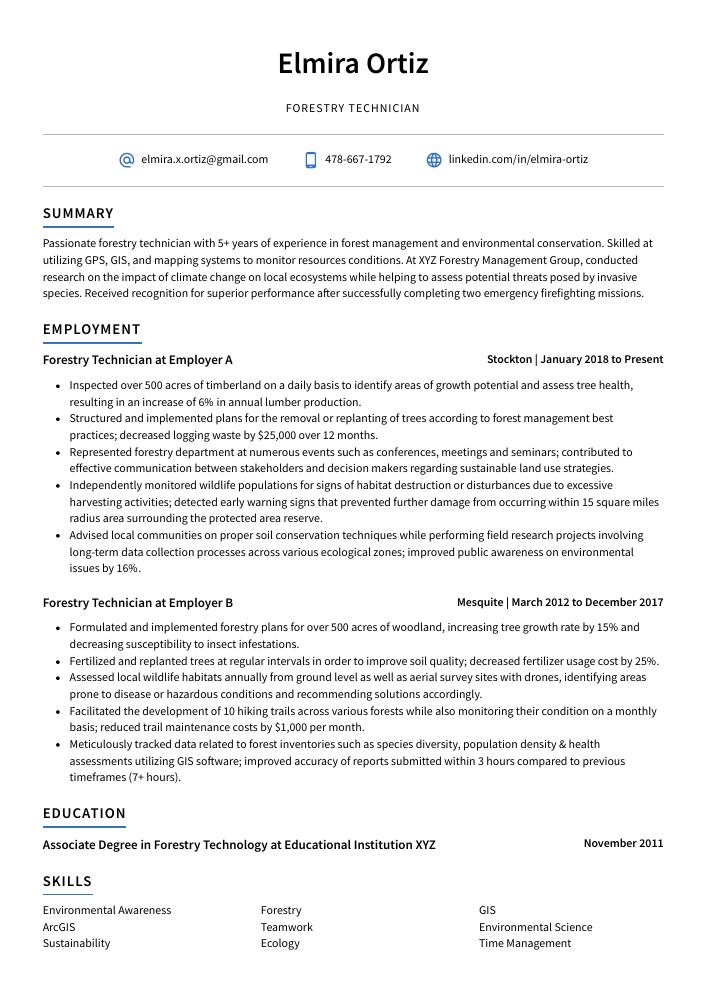Forestry Technician Resume Guide
Forestry technicians work to protect and conserve forests. They monitor forest health, survey land for timber resources, develop plans to manage wildlife habitats, conduct research on tree species and diseases, inspect logging sites for compliance with regulations, and provide technical assistance in the development of public lands.
You’ve got the skills and knowledge to be a great forestry technician, but employers don’t know who you are. To make them aware of your qualifications, write a resume that highlights your achievements in the field.
This guide will walk you through the entire process of creating a top-notch resume. We first show you a complete example and then break down what each resume section should look like.
Table of Contents
The guide is divided into sections for your convenience. You can read it from beginning to end or use the table of contents below to jump to a specific part.
Forestry Technician Resume Sample
Elmira Ortiz
Forestry Technician
[email protected]
478-667-1792
linkedin.com/in/elmira-ortiz
Summary
Passionate forestry technician with 5+ years of experience in forest management and environmental conservation. Skilled at utilizing GPS, GIS, and mapping systems to monitor resources conditions. At XYZ Forestry Management Group, conducted research on the impact of climate change on local ecosystems while helping to assess potential threats posed by invasive species. Received recognition for superior performance after successfully completing two emergency firefighting missions.
Experience
Forestry Technician, Employer A
Stockton, Jan 2018 – Present
- Inspected over 500 acres of timberland on a daily basis to identify areas of growth potential and assess tree health, resulting in an increase of 6% in annual lumber production.
- Structured and implemented plans for the removal or replanting of trees according to forest management best practices; decreased logging waste by $25,000 over 12 months.
- Represented forestry department at numerous events such as conferences, meetings and seminars; contributed to effective communication between stakeholders and decision makers regarding sustainable land use strategies.
- Independently monitored wildlife populations for signs of habitat destruction or disturbances due to excessive harvesting activities; detected early warning signs that prevented further damage from occurring within 15 square miles radius area surrounding the protected area reserve.
- Advised local communities on proper soil conservation techniques while performing field research projects involving long-term data collection processes across various ecological zones; improved public awareness on environmental issues by 16%.
Forestry Technician, Employer B
Mesquite, Mar 2012 – Dec 2017
- Formulated and implemented forestry plans for over 500 acres of woodland, increasing tree growth rate by 15% and decreasing susceptibility to insect infestations.
- Fertilized and replanted trees at regular intervals in order to improve soil quality; decreased fertilizer usage cost by 25%.
- Assessed local wildlife habitats annually from ground level as well as aerial survey sites with drones, identifying areas prone to disease or hazardous conditions and recommending solutions accordingly.
- Facilitated the development of 10 hiking trails across various forests while also monitoring their condition on a monthly basis; reduced trail maintenance costs by $1,000 per month.
- Meticulously tracked data related to forest inventories such as species diversity, population density & health assessments utilizing GIS software; improved accuracy of reports submitted within 3 hours compared to previous timeframes (7+ hours).
Skills
- Environmental Awareness
- Forestry
- GIS
- ArcGIS
- Teamwork
- Environmental Science
- Sustainability
- Ecology
- Time Management
Education
Associate Degree in Forestry Technology
Educational Institution XYZ
Nov 2011
Certifications
Certified Forestry Technician
Society of American Foresters
May 2017
1. Summary / Objective
A resume summary/objective is a great way to introduce yourself and your qualifications as a forestry technician. In this section, you can highlight the skills that make you stand out from other applicants such as your experience in tree planting, forest management plans, and wildlife surveys. You could also mention any certifications or awards related to forestry that demonstrate your expertise in the field.
Below are some resume summary examples:
Energetic Forestry Technician with 6+ years of experience in planning, managing and conducting forestry operations. Proficient in the use of GIS software for land survey analysis and development. Excellent communication skills that enable successful collaboration with coworkers, landowners and other stakeholders to ensure compliance with safety protocols. Seeking to join ABC Company as a Forestry Technician to help manage forest resources responsibly.
Skilled forestry technician with a background in forest management and conservation. Experienced in surveying, monitoring, reporting on the health of forests and implementing sustainable practices to ensure their longevity. Adept at coordinating field crews for data collection and engaging stakeholders in dialogue about land-use policy. Committed to promoting responsible stewardship of natural resources while meeting organizational objectives.
Driven forestry technician with 5+ years of experience in forest management, fire prevention and suppression. Seeking to increase the productivity and sustainability of ABC’s forests by utilizing my expertise in soil erosion control, tree planting, harvesting practices and wildlife habitat improvement. My extensive fieldwork has given me an intimate knowledge of the flora, fauna and ecosystems present within a variety of landscapes.
Determined forestry technician with a passion for the environment and over 5 years of experience in forest management, conservation, and research. Experienced in soil sampling and analysis, monitoring wildlife populations on public lands, analyzing forestry data using GIS software. At XYZ Forestry Center supervised a team of 10 technicians to successfully complete 3 large-scale projects within budget constraints.
Proficient forestry technician with 10+ years of experience in the forestry, logging, and resource management industries. At XYZ Company, managed a crew of 8 to complete 20 projects on time and under budget. Developed an efficient tracking system for timber resources that increased productivity by 25%. Experienced in operating heavy equipment such as bulldozers, skidders, and feller bunchers.
Diligent forestry technician with 6+ years of experience in data collection, environmental conservation, and forest management. Seeking to join ABC Forestry as a resource manager to support the growth of sustainable forests while preserving biodiversity. In prior roles, led reforestation projects that restored over 100 hectares of land and increased tree cover by 19%.
Accomplished forestry technician with 5+ years of experience in forest management, conservation, and timber harvesting. Skilled at developing innovative strategies to improve the health and sustainability of local forests while providing high-quality customer service. Seeking to leverage problem-solving skillset and hands-on expertise as part of ABC’s Forestry team.
Amicable and hardworking Forestry Technician with 5+ years of experience in forest management and conservation. Highly knowledgeable regarding the different forestry techniques, protocols, and strategies to ensure a safe environment for both humans and wildlife. Seeking to join ABC Company to help preserve natural habitats while promoting sustainable practices.
2. Experience / Employment
The work history/experience section should be written in reverse chronological order, meaning your most recent job is listed first. You should also use bullet points to make it easier for the reader to digest what you have said.
When writing this section, think about how you can provide details on the tasks and responsibilities that were part of your role as a forestry technician. Focus on quantifiable results where possible; instead of saying “Conducted tree surveys,” say something like “Conducted detailed tree surveys across 50 acres of land resulting in an accurate assessment of timber resources.”
To write effective bullet points, begin with a strong verb or adverb. Industry specific verbs to use are:
- Monitored
- Collected
- Assessed
- Analyzed
- Identified
- Inspected
- Operated
- Pruned
- Cultivated
- Controlled
- Maintained
- Planted
- Harvested
- Fertilized
- Protected
Other general verbs you can use are:
- Achieved
- Advised
- Compiled
- Coordinated
- Demonstrated
- Developed
- Expedited
- Facilitated
- Formulated
- Improved
- Introduced
- Mentored
- Optimized
- Participated
- Prepared
- Presented
- Reduced
- Reorganized
- Represented
- Revised
- Spearheaded
- Streamlined
- Structured
- Utilized
Below are some example bullet points:
- Proficiently managed various forestry operations including tree planting, cutting and harvesting over 3,000 acres of land; reduced the average time to complete projects by 20%.
- Compiled data on forest health conditions such as soil composition, disease prevalence in trees and animal population levels; used findings to effectively plan future management strategies for a healthier ecosystem.
- Cultivated relationships with other forestry professionals across multiple state agencies for resource sharing initiatives that increased productivity by 40%.
- Participated in reforestation efforts through wildflower seedling transplants from nurseries into natural habitats; planted over 100,000 native species in two years resulting in the revival of endangered wildlife populations.
- Controlled invasive species along protected lands using herbicides & pesticides while adhering strictly to EPA regulations; decreased weed infestation rates by 25% within 6 months of implementation of pest control methods.
- Spearheaded the development of forestry management plans to conserve wildlife, protect habitats and increase biodiversity while ensuring compliance with governmental regulations; achieved a 20% reduction in timber harvesting costs.
- Collected comprehensive data on forest conditions, including tree species composition, disease levels and soil erosion measures; monitored trends across 1,000+ acres over a period of 5 years.
- Developed protocols for controlling pests & diseases as well as replanting areas affected by logging activities; reduced the spread of insect infestation by 25%.
- Presented findings from various studies conducted on protected forests to stakeholders such as government agencies and conservation groups; implemented their recommendations which led to an overall improvement in ecosystem health & stability within 2 months’ time frame.
- Successfully coordinated large-scale reforestation projects involving up to 50 volunteers at once during peak periods; planted 10 million trees across 15 national parks in one year alone.
- Reorganized and streamlined the forestry operation processes, resulting in a 9% increase in productivity.
- Pruned over 2,000 trees per month to identify and remove dead wood for forest health and safety; decreased tree mortality rate by 22%.
- Coordinated with other technicians on 400+ forestry projects throughout the year involving soil testing, surveying & mapping land boundaries, planting new seedlings and harvesting timber products from existing forests.
- Thoroughly inspected timber stands at least once every two weeks to assess their overall condition; identified potential hazards that could lead to fires or disease outbreaks before they posed any risks of damage or destruction.
- Implemented efficient data collection methods which allowed records of all activities related to forestry management operations to be updated within minutes instead of hours previously required for manual entry process; slashed paperwork time by 45%.
- Utilized a variety of forestry tools and equipment, including chainsaws, brush cutters and herbicides to clear undergrowth from forests; reduced vegetation growth by 10% in a 200-acre area.
- Improved forest health through various techniques such as thinning dense patches of trees and removing deadwood material for biomass production; increased tree survival rate by 12%.
- Effectively managed the collection of field data related to soil moisture content, temperature changes, species count & diversity levels within the forest ecosystem; generated detailed reports based on findings.
- Optimized use of resources while reforesting an acreage block with native plants and grasses according to local conservation regulations; decreased water usage per plant by 15%.
- Demonstrated strong communication skills when engaging stakeholders regarding environmental sustainability initiatives that impacted over 2000 acres surrounding the region’s ecology center.
- Competently maintained the health and safety of 500+ acres of forestry land; monitored, analyzed and reported on environmental conditions such as soil erosion, water quality, flora/fauna populations & timber harvesting to ensure compliance with state forestry laws.
- Introduced sustainable forest management techniques that resulted in a 15% reduction in deforestation over 2 years and improved overall tree growth rate by 10%.
- Operated various power equipment including chainsaws, brush saws, chippers and stump grinders for trimming trees or clearing underbrush safely; completed projects within allocated timeframes without compromising safety standards.
- Prepared detailed mapping reports using GIS software to document locations of new trails; generated accurate plots measuring specific areas not accessible via vehicle transportation while adhering to professional surveying protocols at all times.
- Assisted experienced foresters with creating plans for future reforestation activities along with population surveys which accurately determined number of species present in each area surveyed (+500).
- Substantially reduced the risk of forest fires by 75% through regular maintenance and monitoring of over 25 miles of trails in state parks.
- Protected endangered species habitats located within the park boundaries, utilizing safe and sustainable forestry practices to ensure their survival for future generations.
- Expedited logging operations on-site by training a team of 10 technicians in efficient tree cutting techniques; increased daily output rate from 7 logs/hour to 15 logs/hour within two months.
- Identified potential infestations or disease outbreaks early, providing expert recommendations for treatments that effectively eliminated pests while preserving surrounding vegetation cover and soil health; saved $1,000 worth of damage costs last year alone due to quick action taken at first signs of trouble.
- Monitored wildlife activity throughout assigned areas twice per day using advanced tracking technology; reported any unusual behavior patterns or migratory changes back to supervisors immediately upon discovery so appropriate protective measures could be implemented accordingly.
- Reduced the amount of deadwood in forestry areas by 30% utilizing effective pruning and cutting techniques.
- Revised forest management plans for 3 national parks, resulting in a 10% increase in reforestation efforts over the last 6 months.
- Analyzed regional tree populations to identify vulnerable species and developed strategies to protect them from environmental damage; successfully increased population numbers by 25%.
- Achieved certification as an arborist after completing 100+ hours of continuing education courses on sustainable forestry practices, ensuring that all activities are performed safely with minimal disruption to wildlife habitats & ecosystems.
- Efficiently trimmed & shaped trees using chainsaws, chippers & ladders while adhering strictly to all safety protocols; improved work efficiency by 28%, allowing tasks to be completed up to 4 hours ahead of schedule every week on average.
- Harvested and managed over 1,500 acres of forest land each season, ensuring that sustainable forestry practices were adhered to.
- Planted and cultivated 10+ species of trees in a variety of environments and soil conditions; increased the rate of successful tree planting by 23%.
- Consistently monitored wildlife habitat areas for signs of damage or disruption caused by unnatural activities such as illegal logging or poaching; reported findings to relevant authorities promptly.
- Mentored junior colleagues on proper safety protocols when working with tools & machinery in hazardous outdoor settings, reducing workplace injuries by 15%.
3. Skills
Two organizations that have advertised for a position with the same title may be searching for individuals whose skills are quite different. For instance, one may be looking for someone with a background in tree identification and another might require experience in soil sampling.
It is important to tailor the skills section of your resume to each job you are applying for, as many companies use applicant tracking systems these days which scan resumes for specific keywords before passing them on to human recruiters.
The most relevant skills should also be discussed in more detail elsewhere on your resume, such as the summary or work experience sections. This will help demonstrate that you have an understanding of what is required and can apply it effectively if hired.
Below is a list of common skills & terms:
- ArcGIS
- Data Analysis
- Data Collection
- Ecology
- English
- Environmental Awareness
- Environmental Education
- Environmental Policy
- Environmental Science
- Field Work
- Forest Management
- Forestry
- GIS
- GPS
- Geographic Information Systems
- Government
- Natural Resource Management
- Natural Resources
- Nonprofits
- Plant Identification
- Sustainability
- Teaching
- Team Leadership
- Teamwork
- Time Management
4. Education
Mentioning an education section on your resume will depend on how far you are in your career. If you just graduated and have no work experience, include an education section below your resume objective. However, if you have been working as a forestry technician for years with plenty of different responsibilities to showcase, omitting the education section is perfectly acceptable.
If including an education section is necessary, try to mention courses and subjects related to the job role such as natural resource management or ecology that demonstrate expertise in forestry techniques.
Associate Degree in Forestry Technology
Educational Institution XYZ
Nov 2011
5. Certifications
Certifications are a great way to demonstrate your expertise in a particular field. They show potential employers that you have taken the time and effort to become certified, which is an indication of dedication and commitment.
Including certifications on your resume can help you stand out from other applicants by showing that you are knowledgeable and capable in certain areas. Be sure to list any relevant certifications when applying for jobs so they can be considered as part of your application.
Certified Forestry Technician
Society of American Foresters
May 2017
6. Contact Info
Your name should be the first thing a reader sees when viewing your resume, so ensure its positioning is prominent. Your phone number should be written in the most commonly used format in your country/city/state, and your email address should be professional.
You can also choose to include a link to your LinkedIn profile, personal website, or other online platforms relevant to your industry.
Finally, name your resume file appropriately to help hiring managers; for Elmira Ortiz, this would be Elmira-Ortiz-resume.pdf or Elmira-Ortiz-resume.docx.
7. Cover Letter
Writing a cover letter is a great way to make your job application stand out from the crowd. It’s an opportunity for you to explain why you are well-suited for the position and what makes you unique as a professional.
Cover letters usually consist of 2 – 4 paragraphs, though some employers may require more or fewer depending on their specific requirements. They should be tailored to each role and provide additional information that isn’t included in your resume or CV.
Below is an example cover letter:
Dear Marcella,
I am writing to apply for the Forestry Technician position at your company. I am a recent graduate of the forestry program at [college name] and have previous experience working in the forestry industry, which makes me confident that I would be a valuable asset to your team.
In my previous role as a Forestry Technician with the [company name], I was responsible for conducting forest inventory surveys, tree planting, and brush clearing projects. I also assisted with developing Forest management plans and implementing best practices for sustainable forestry operations. My hands-on experience has given me a strong understanding of how to manage forests responsibly, and I am excited to put my skills to work in a new environment.
I am knowledgeable about all aspects of forestry operations, including tree identification, surveying techniques, GPS mapping, and forest ecology. I am also familiar with OSHA safety regulations related to logging activities. My education and practical experience have equipped me with the skills necessary to excel in this position.
I am eager to utilize my skills and knowledge in a new setting, and I believe that I would make an excellent addition to your team. Thank you for your consideration; please do not hesitate to contact me if you have any questions or need any additional information about my qualifications.
Sincerely,
Elmira
Forestry Technician Resume Templates
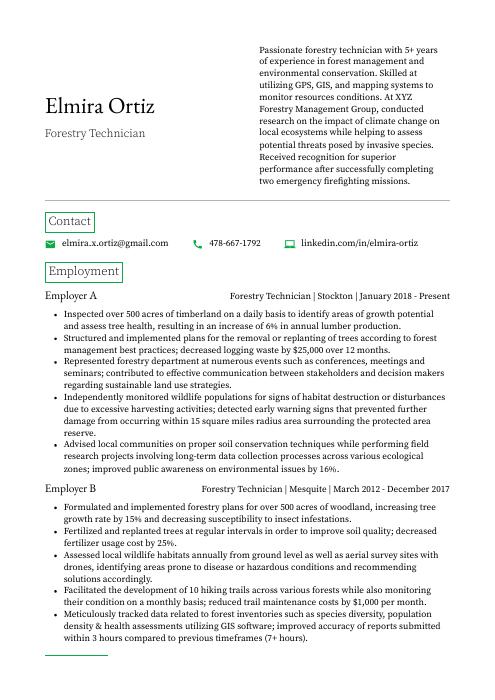 Quokka
Quokka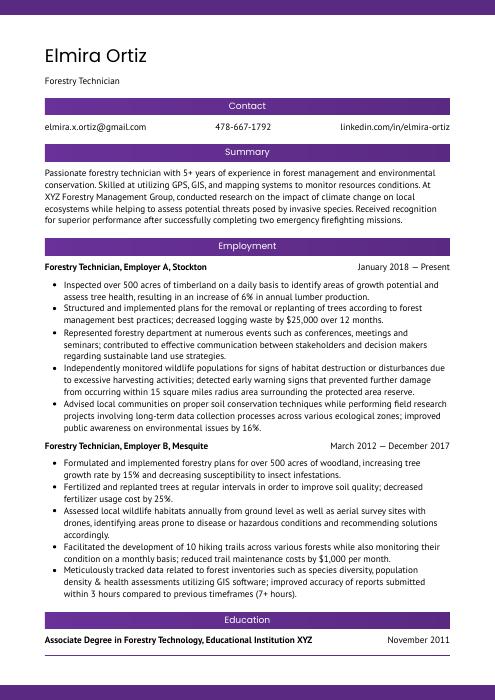 Jerboa
Jerboa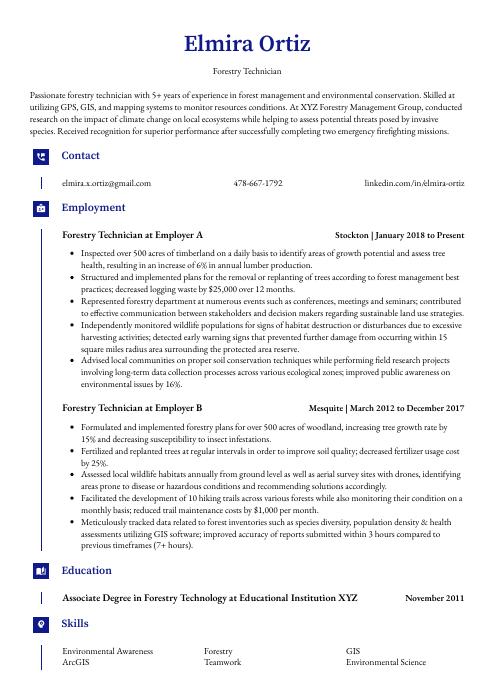 Gharial
Gharial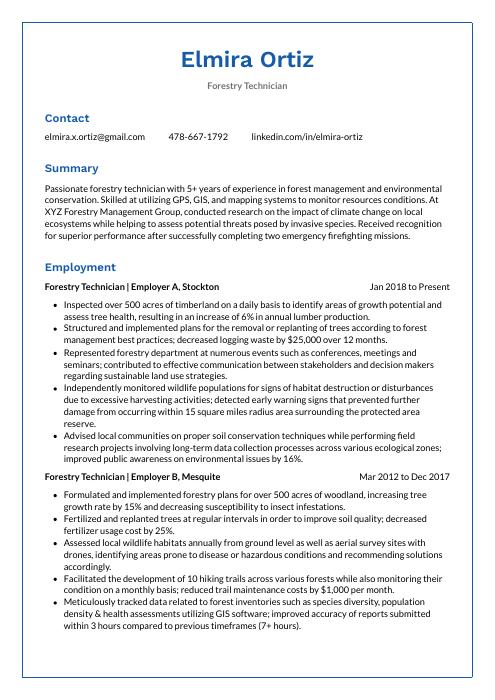 Markhor
Markhor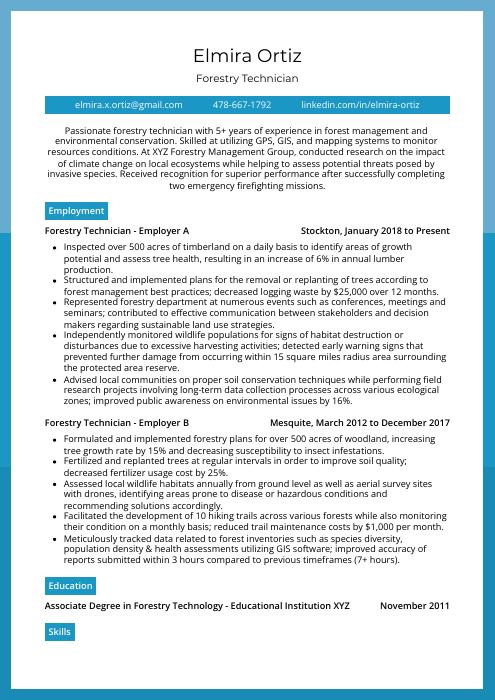 Rhea
Rhea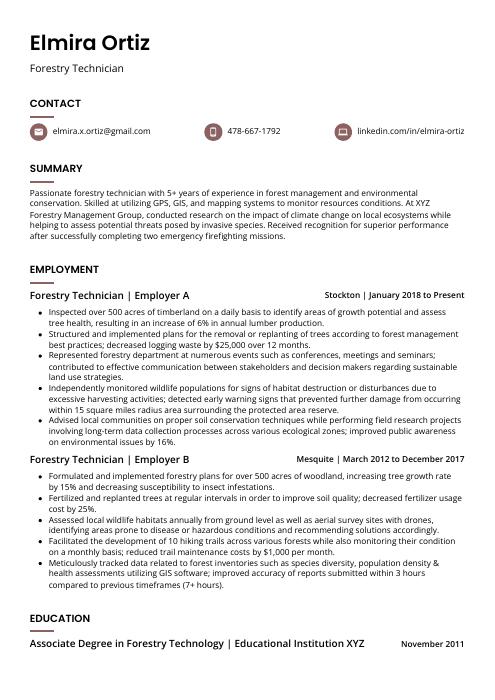 Fossa
Fossa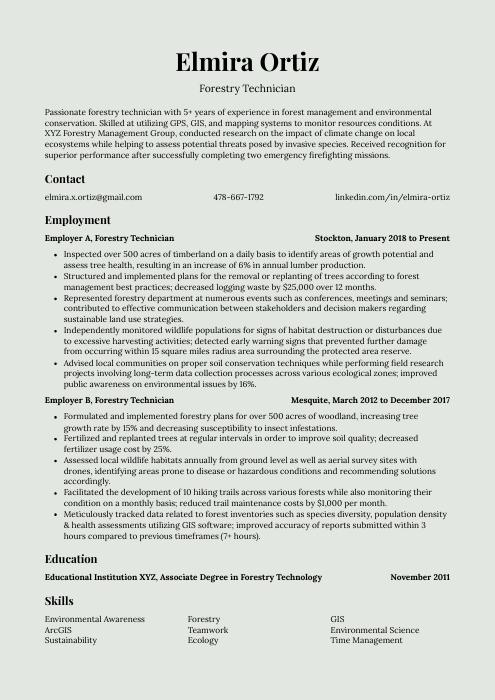 Saola
Saola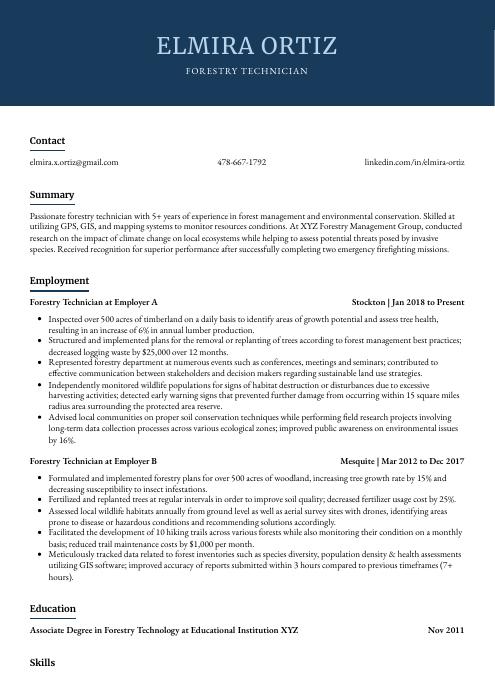 Bonobo
Bonobo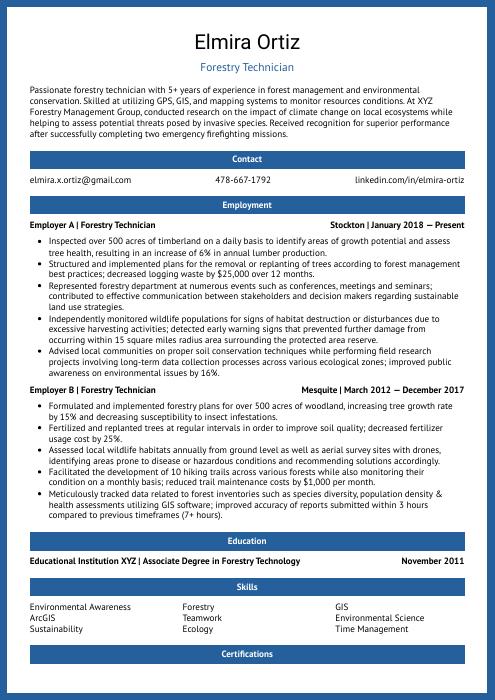 Ocelot
Ocelot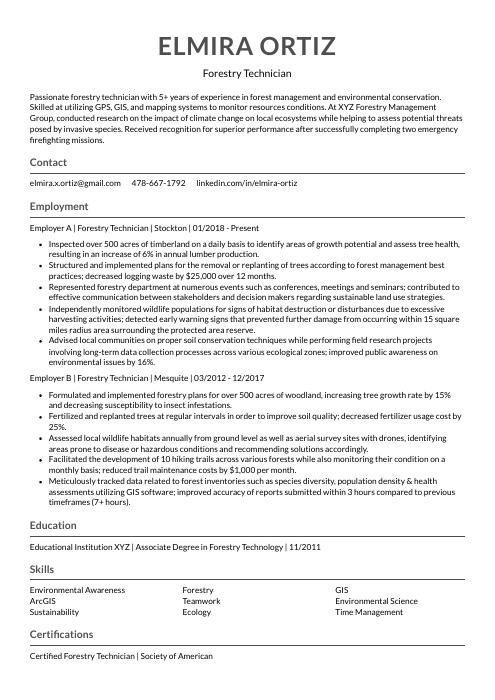 Indri
Indri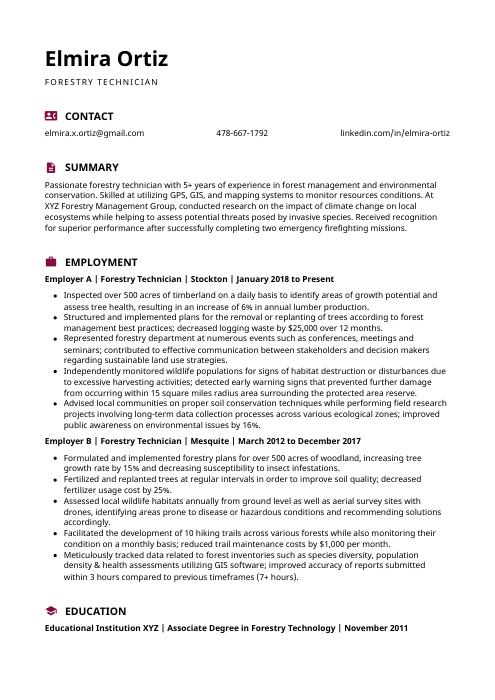 Hoopoe
Hoopoe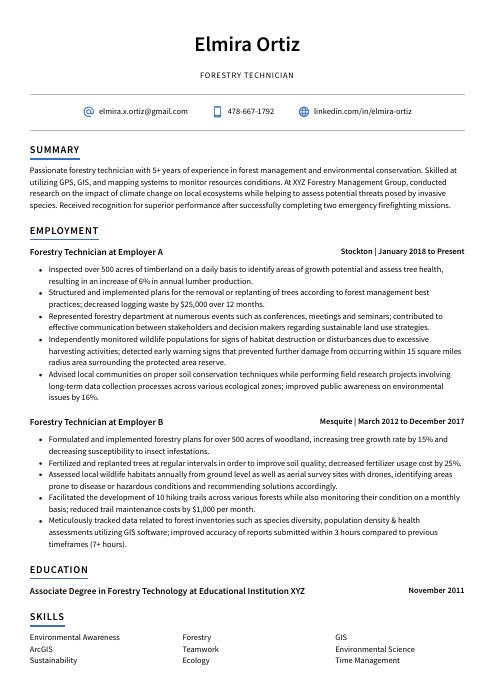 Axolotl
Axolotl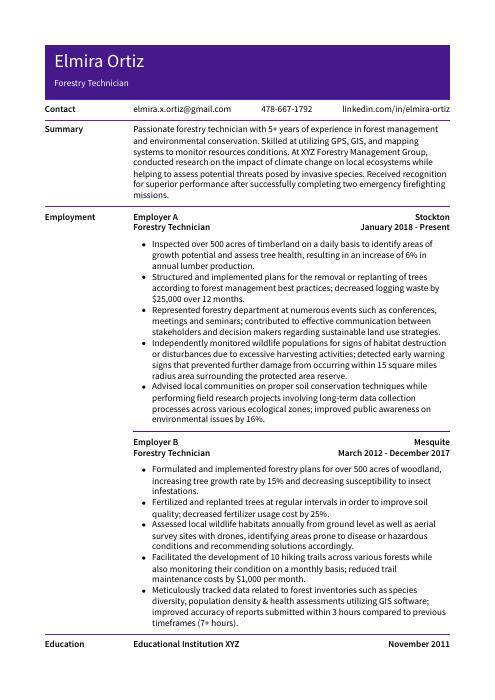 Pika
Pika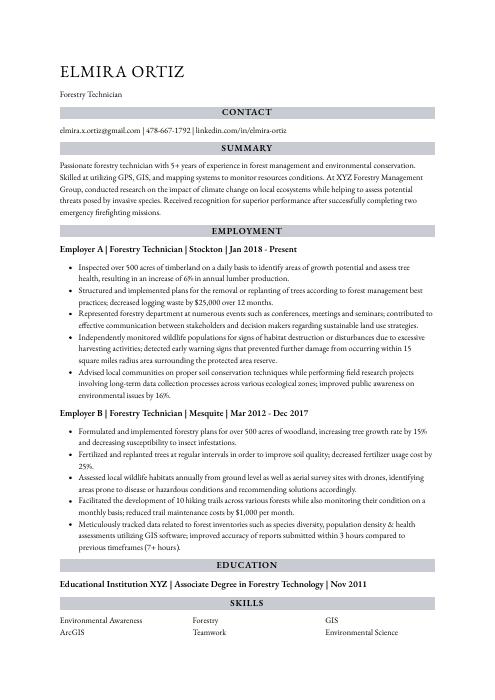 Numbat
Numbat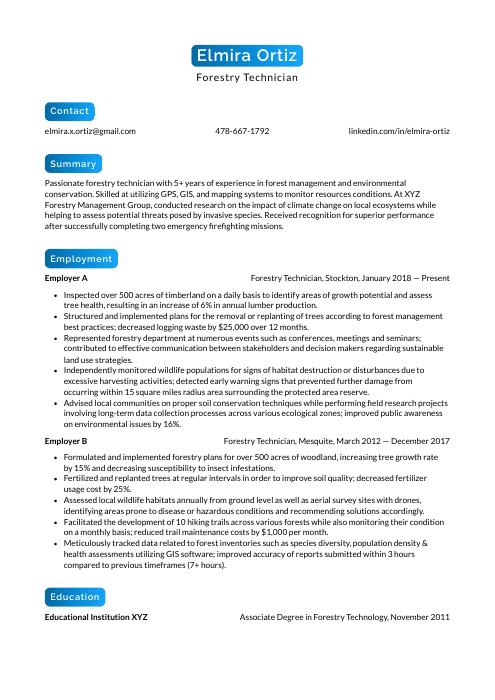 Kinkajou
Kinkajou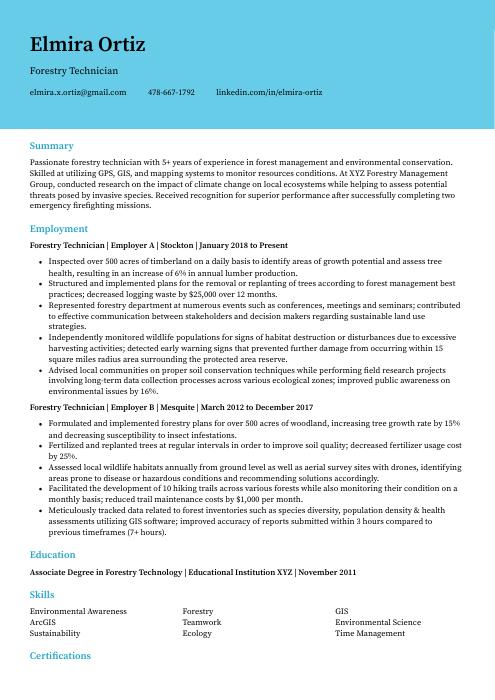 Dugong
Dugong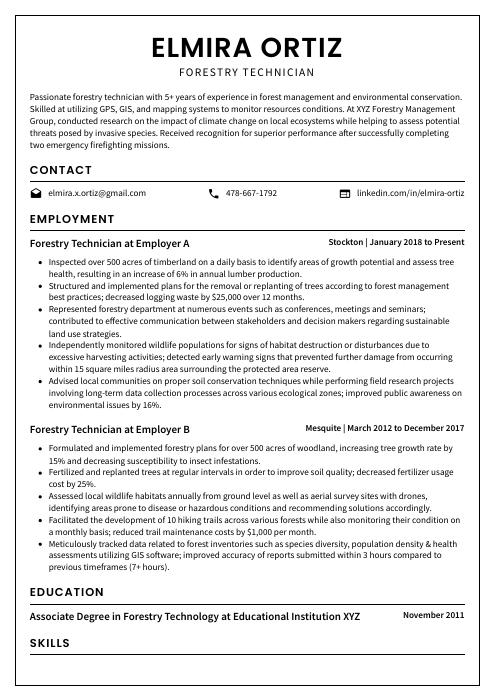 Cormorant
Cormorant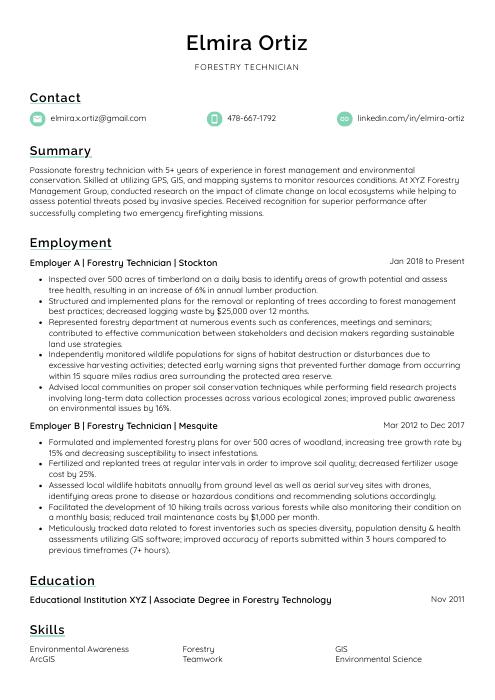 Lorikeet
Lorikeet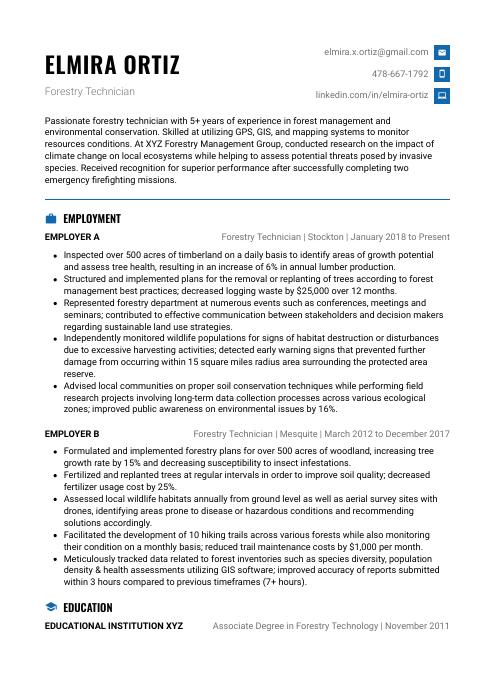 Echidna
Echidna Rezjumei
Rezjumei
